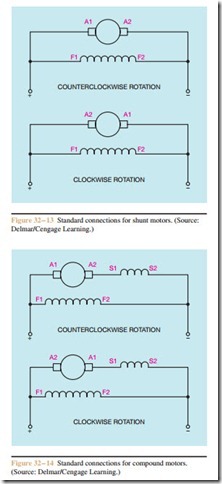Standard Connections
When DC motors are wound, the terminal leads are marked in a standard manner. This permits the direction of rotation to be determined when the motor windings are connected. The direction of rotation is determined by facing the commutator end of the motor, which is generally located on the rear of the motor, but not always. Figure 32– 12 shows the standard connections for a series motor, Figure 32– 13 shows the standard connections for a shunt motor, and Figure 32– 14 shows the standard connections for a cumulative compound motor.
Review Questions
1. How can a DC motor be made to operate below its normal speed?
2. Name the three basic types of DC motors.
3. Explain the physical difference between series field windings and shunt field windings.
4. The speed regulation of a DC motor is proportional to what?
5. What connection is made to form a long shunt compound motor?
6. Explain the difference between the connection of a cumulative compound and a differential compound motor.
7. How is the direction of rotation of a DC motor changed?
8. Why is it important to reverse only the armature leads when changing the rotation of a compound motor?

